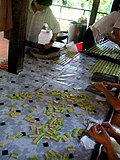Candy making
The process of creating confections from sugar and other ingredients
Candy making is the art and science of creating confectionery products, primarily from sugar and other ingredients. This process involves various techniques and methods to produce a wide range of candies, from simple hard candies to complex chocolates and nougat.
History[edit]
The history of candy making dates back to ancient times when honey was used as a sweetener. The development of sugar refining techniques in the Middle Ages allowed for the creation of more sophisticated confections. By the 19th century, candy making had become a popular industry, with the invention of new machinery and techniques that allowed for mass production.
Ingredients[edit]
The primary ingredient in candy making is sugar, which can be used in various forms such as granulated sugar, powdered sugar, or corn syrup. Other common ingredients include:
Techniques[edit]
Candy making involves several techniques, each suited to different types of candy. Some of the most common techniques include:
Boiling[edit]
Boiling is a fundamental technique in candy making, used to dissolve sugar and create syrups. The temperature to which the syrup is boiled determines the type of candy produced, such as soft caramels or hard candies.
Tempering[edit]
Tempering is a process used in chocolate making to stabilize the cocoa butter crystals, resulting in a glossy finish and a crisp snap. This involves carefully heating and cooling the chocolate to specific temperatures.
Pulling[edit]
Pulling is used to aerate sugar mixtures, creating a light and chewy texture. This technique is commonly used in making taffy and nougat.
Molding[edit]
Molding involves pouring liquid candy into molds to create specific shapes. This is often used in the production of chocolates and gummy candies.
Types of Candy[edit]
Candy can be categorized into several types based on their texture and ingredients:
Equipment[edit]
Candy making requires specific equipment to achieve the desired results. Some essential tools include:
Safety[edit]
Candy making involves working with high temperatures and hot sugar syrups, which can cause burns. It is important to follow safety precautions, such as using protective gear and maintaining a clean workspace.
Related pages[edit]
-
Ryan Berley Pouring Candy Molds
-
Candy in the Making in Nablus
-
Coconut Candy Making, Vietnam
-
Hard Candy
-
Cotton Candy Making
-
Spinning Head of the Cotton Candy Maker
-
Cotton Candy
-
Marshmallow Creme
Ad. Transform your life with W8MD's Budget GLP-1 injections from $75


W8MD offers a medical weight loss program to lose weight in Philadelphia. Our physician-supervised medical weight loss provides:
- Weight loss injections in NYC (generic and brand names):
- Zepbound / Mounjaro, Wegovy / Ozempic, Saxenda
- Most insurances accepted or discounted self-pay rates. We will obtain insurance prior authorizations if needed.
- Generic GLP1 weight loss injections from $75 for the starting dose.
- Also offer prescription weight loss medications including Phentermine, Qsymia, Diethylpropion, Contrave etc.
NYC weight loss doctor appointmentsNYC weight loss doctor appointments
Start your NYC weight loss journey today at our NYC medical weight loss and Philadelphia medical weight loss clinics.
- Call 718-946-5500 to lose weight in NYC or for medical weight loss in Philadelphia 215-676-2334.
- Tags:NYC medical weight loss, Philadelphia lose weight Zepbound NYC, Budget GLP1 weight loss injections, Wegovy Philadelphia, Wegovy NYC, Philadelphia medical weight loss, Brookly weight loss and Wegovy NYC
|
WikiMD's Wellness Encyclopedia |
| Let Food Be Thy Medicine Medicine Thy Food - Hippocrates |
Medical Disclaimer: WikiMD is not a substitute for professional medical advice. The information on WikiMD is provided as an information resource only, may be incorrect, outdated or misleading, and is not to be used or relied on for any diagnostic or treatment purposes. Please consult your health care provider before making any healthcare decisions or for guidance about a specific medical condition. WikiMD expressly disclaims responsibility, and shall have no liability, for any damages, loss, injury, or liability whatsoever suffered as a result of your reliance on the information contained in this site. By visiting this site you agree to the foregoing terms and conditions, which may from time to time be changed or supplemented by WikiMD. If you do not agree to the foregoing terms and conditions, you should not enter or use this site. See full disclaimer.
Credits:Most images are courtesy of Wikimedia commons, and templates, categories Wikipedia, licensed under CC BY SA or similar.
Translate this page: - East Asian
中文,
日本,
한국어,
South Asian
हिन्दी,
தமிழ்,
తెలుగు,
Urdu,
ಕನ್ನಡ,
Southeast Asian
Indonesian,
Vietnamese,
Thai,
မြန်မာဘာသာ,
বাংলা
European
español,
Deutsch,
français,
Greek,
português do Brasil,
polski,
română,
русский,
Nederlands,
norsk,
svenska,
suomi,
Italian
Middle Eastern & African
عربى,
Turkish,
Persian,
Hebrew,
Afrikaans,
isiZulu,
Kiswahili,
Other
Bulgarian,
Hungarian,
Czech,
Swedish,
മലയാളം,
मराठी,
ਪੰਜਾਬੀ,
ગુજરાતી,
Portuguese,
Ukrainian







